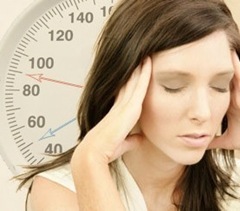 Arterial pressure is one of the main indicators of the constancy of the internal environment of the human body. It consists of two indicators: systolic and diastolic blood pressure.
Arterial pressure is one of the main indicators of the constancy of the internal environment of the human body. It consists of two indicators: systolic and diastolic blood pressure.
Systolic BP fluctuates in the interval 110 - 130 mm Hg. Diastolic in norm should not deviate from 65 - 95 mm Hg. Any deviation from the norm immediately affects the person's normal health.
Low or low blood pressure, hypotension, arterial hypotension - all these are the names of the condition when the blood pressure level of a person at rest is below the norm - 100/60 mm. gt; Art. Low blood pressure is not a diagnosis, since the modern medical community does not recognize hypotension as a disease.
Constant low pressure, as a rule, is congenital, i.e. is passed from parents to children. What to do when the pressure is low, the causes of this condition, as well as the main symptoms we will consider in this article.
Causes of low pressure
Hypotonic pressure reduction is considered to be below 100/60 mm Hg. This is a problem for both young people and the elderly. This decrease can be physiological or pathological.
Low cause pressure can be very extensive. Let us consider in more detail the conditions and diseases that can be the cause of low blood pressure:
- Heart Dysfunction. A decrease in pressure can cause bradycardia, heart failure, or some problems with heart valves.
- Pregnancy. BP probably decreases because during pregnancy, the circulatory system of a woman is rapidly increasing in volume. This is normal, and BP usually returns to its original level after childbirth.
- Endocrine disorders- hypothyroidism, hypoglycemia, in some cases, diabetes, as well as adrenal insufficiency - provoke a decrease in the tone of blood vessels.
- Dehydration, as a result of increased physical exertion, diarrhea, or abuse of diuretics.
- Blood loss. Loss of large amounts of blood as a result of severe injuries or internal bleeding leads to a decrease in the volume of circulating blood and a sudden drop in blood pressure.
- Severe allergic reactions(anaphylaxis) is another reason that low blood pressure occurs. Anaphylactic reaction can cause breathing problems, urticaria, itching, laryngeal edema and a drop in blood pressure.
- Starvation(malnutrition). The lack of vitamin B12 and folic acid can cause anemia, which is accompanied by a decrease in blood pressure.
Proceeding from the foregoing, treatment of low diastolic pressure requires a detailed investigation of the cause. It is strongly recommended to consult a cardiologist, endocrinologist, nephrologist, therapist, and in some cases - an oncologist, hematologist, gastroenterologist, psychotherapist.
What to do with low pressure?
So, you have low blood pressure - what to do? Everything depends on the person and his state of health. A large number of young people are hypotonic. The figures of blood pressure in them are constantly in the range of 90-100 / 60 mm. gt; Art. In this case, a person feels well, his work capacity is not violated.
Sometimes a healthy person develops a hypotonic state as a result of stress, unfavorable weather conditions. If the lowered pressure is combined with a headache, weakness, dizziness, drowsiness, nausea - you need to take action.
Medication for low blood pressure includes the administration of caffeine-based drugs, herbal preparations that have a stimulating effect. When hypotension is useful to start the day with a cup of well-brewed coffee. However, it is not necessary to abuse caffeine: a so-called paradoxical reaction of blood vessels is possible - expansion and, as a result, an even lowering of blood pressure.
More walk in the fresh air - in the park, on the street before going to bed, walk more. At low pressure, any physical activity is simply necessary. Also, think over the food ration so that there is always chrome in it. If you are worried about low lower (diastolic) pressure with an elevated upper (systolic) at the same time, you should go to the cardiologist immediately. Since such a symptom can talk about aortic valve insufficiency.
How to raise low blood pressure at home
Rapidly raise blood pressure will help the following drugs:
- Ascorbicum (0.5 g) and green tea extract (2 tablets).
- Aralia Manchurian (15 drops) and pantocrine (30 drops).
- Tincture of Rhodiola rosea and Leuzea (25 drops).
- Grape juice (1 glass) and tincture of ginseng (30 drops).
- Tincture of Chinese magnolia vine (1 spoonful), cordiamine (25 drops) and glycine (1 tablet under the tongue).
Medicamental treatment of low blood pressure is the reception of stimulant drugs containing caffeine, lemon or succinic acid - they are prescribed by a doctor, visits to which should be regular if you have hypotension.
Low blood pressure and high heart rate: main causes
 Unequivocally answer the question what can cause low pressure, but at the same time a high pulse, it is impossible.
Unequivocally answer the question what can cause low pressure, but at the same time a high pulse, it is impossible.
To make the final diagnosis it is worth to contact several specialists who will help to identify the real causes of the problem. The patient should be examined first of all by a cardiologist, later by a therapist, and also by an endocrinologist.
Among the factors that provoke such violations in the work of the cardiovascular system, we can name the following:
- Significant loss of blood.
- Shock of different etiology(due to allergic reaction, trauma, toxins and infections, as well as cardiogenic origin), which is characterized by traditional symptoms of hypotension.
- Vegetosovascular dystonia, which occurs with the development of specific crises and is characterized by a sharp weakness and dizziness, pallor of the mucous membranes and skin, a sharp decrease in blood pressure and the appearance of severe tachycardia.
- The reason may bepregnancy, because at this time in the body of a woman reduces the tone of the vessels due to the influence of the hormone progesterone. In addition, the increase in the volume of circulating blood is characteristic, therefore, during pregnancy, it is quite often possible to detect three disorders - tachycardia, iron deficiency anemia and low blood pressure.
- Dehydration, which is observed with prolonged vomiting and diarrhea, significant physical exertion, as well as with a thermal shock.
- The causes of tachycardia with a simultaneous decrease in blood pressure also include acute inflammatory processes in the internal organs (for example, acute pancreatitis), in which the distribution of blood changes.
If the pulse is increased and the pressure is lowered, the patient feels pain in the heart area, headache, dizziness, anxiety, fear. There may also be a feeling of fullness of the stomach, nausea, vomiting.
Symptoms
Low cardiac pressure is characterized by the following symptoms:
- weakness, malaise, decreased efficiency and memory;
- headaches and dizziness, darkening in the eyes;
- weather sensation, sensation of cold;
- tachycardia, pain in the heart.
In more neglected cases, when pressure can drop to critical markers (50 mm Hg. Art. and below) the following symptoms can be attached to the above symptoms:
- sharp attacks of weakness, fainting;
- fits of vomiting;
- feeling of shortage of air.
Low lower blood pressure is sometimes accompanied by a neurosis, which manifests itself in anxiety, irritability, tearfulness. Depression arises, the mood is changeable.
In pregnancy
Considering this symptom in the context of pregnancy, you can divide two options.
- Hypotension, as a primary condition, takes place before pregnancy and continues with its onset. In this case, there is no risk for the future mother. The fetus can suffer, as against the background of hypotension the rate of vascular blood flow slows down, which inevitably will negatively affect the placental blood circulation of the child. There is a high risk of intrauterine hypoxia of the fetus with all the ensuing consequences.
- Reducing pressure is the result of pregnancy. This is possible with early toxicosis of the first half of the gestational age. Another variant of its reduction is associated with the development of complications during pregnancy in the form of a threatening or started abortion with uterine bleeding. In other cases there is a violation of blood pressure in the direction of its increase.
The best way to diagnose hypotension is to measure pressure with a tonometer.
Some rules for normalizing the low pressure
What else is recommended for prevention? Follow these simple recommendations, and your low pressure will go back to normal.
- Regular night sleep (at least 8 hours)and preferably also lunch for you should become the norm. Do not forget to ventilate the room before going to bed.
- Revise your diet, which should consist of fats, proteins, vitamins C and B1, carbohydrates. There should be a minimum of four meals a day.
- Accustom yourself to a contrasting soul. Start hardening with lukewarm water and go to the cold one. This will strengthen the walls of the vessels and help increase pressure.
- Never stand up sharply, after awakening, lie down for a few more minutes, moving your arms and legs, and only then slowly sit in bed. This is how you can avoid dizziness and morning fainting.
- Properly organize your workplace. Lack of light or a comfortable position for work can cause headaches and lowering of pressure.
- In the evening, lying on his back, lean his feet against the wall to improve the outflow of blood. In this position, you should spend 15 minutes.
These rules are especially relevant for the growing children's organism and for the elderly.
Treatment of low blood pressure
To take medical procedures is necessary only at the first manifestations of hypotension, because at the first stages it is easier to eliminate the negative influence of low pressure on the organism as a whole. As part of the treatment, you should not experiment and rely on your knowledge, it is important to consult a doctor who, after a detailed examination, will prompt an effective scheme in each case.
In the case of low pressure, treatment rarely begins with the administration of pharmaceuticals. To eliminate the problem, it may be enough to change the way of life itself. If this does not help, the patient is recommended and folk remedies, and pharmaceuticals, and even spa treatment.

How to choose probiotics for the intestine: a list of drugs.

Effective and inexpensive cough syrups for children and adults.

Modern non-steroidal anti-inflammatory drugs.

Review of tablets from the increased pressure of the new generation.
 Antiviral drugs are inexpensive and effective.
Antiviral drugs are inexpensive and effective.



